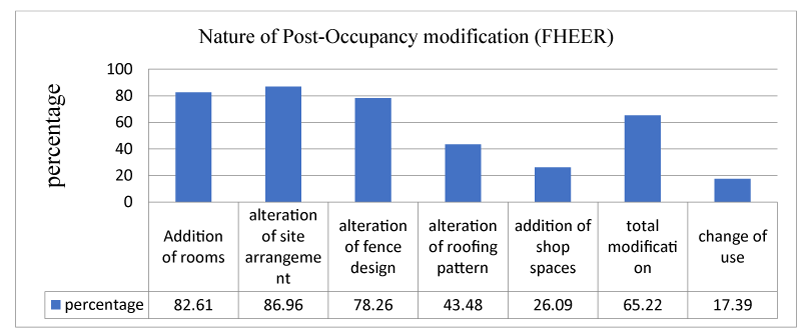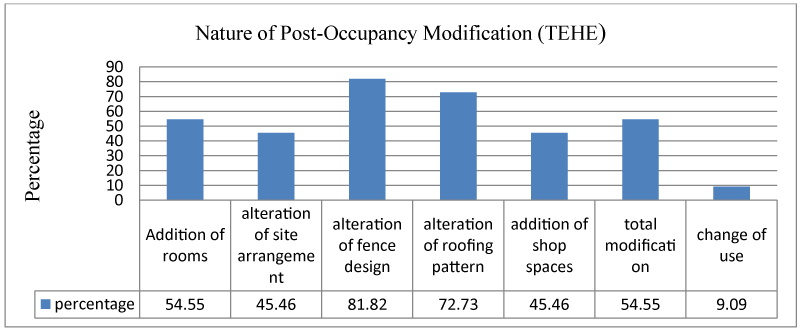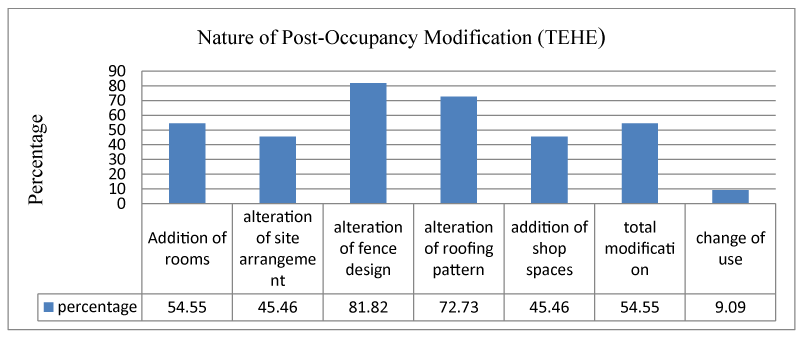Journal of Civil Engineering and Environmental Sciences
The nature of post-occupancy modifications of selected low-income housing estates in Nigeria
Miriam Ijeoma Chukwuma-Uchegbu1 and Muhammad Saidu Aliero2*
2School of Information Technology, Monash University Malaysia
Cite this as
Chukwuma-Uchegbu MI, Aliero MS (2022) The nature of post-occupancy modifications of selected low-income housing estates in Nigeria. J Civil Eng Environ Sci 8(1): 012-017. DOI: 10.17352/2455-488X.000046Copyright License
© 2022 Chukwuma-Uchegbu MI, et al. This is an open-access article distributed under the terms of the Creative Commons Attribution License, which permits unrestricted use, distribution, and reproduction in any medium, provided the original author and source are credited.This paper aims to evaluate the nature of post-occupancy modifications of selected income housing estates in Nigeria. The research adopts both the quantitative and qualitative approaches and is essentially survey-based. Therefore, the research population is all housing units of low-income public housing estates in Owerri Metropolis. A simple random technique was further adopted to select five low-income housing estates within the low-income group for this study. Participants of this study were further sampled and selected based on the following requirements and eligibility criteria - they must be residents in the residential estates under study; they must be household heads (or their representatives) of the buildings in the selected housing estates and the building must have been in existence for over ten years (which is enough time for modification to have taken place). The data were collected through the use of a structured questionnaire and field observations, and analysis of this data relied on the computer-based statistical software called STATA 13.0. Results were presented and discussed, pinpointing the nature of post-occupancy modifications in the five selected low-income housing estates. The results further show various kinds of modifications (addition of rooms, alteration of site arrangement, alteration of fence design, alteration of roofing pattern, addition of shop spaces, change of use, and outright total modification) have taken place across the five housing estates studied.
Introduction
The appraisal of the post-occupancy performance of mass housing in Nigeria has been generalized without any particular focus on the user preference or level of satisfaction of the low-income group of their building in use [1-6]. Evaluating post-occupancy modifications aims to discover how the completed building performs, determine possible misfits, mistakes, or omissions, and accumulate information for future programming and design [7]. According to Watson [8], post-occupancy evaluation is a systematic evaluation of opinions about buildings in use from users’ perspectives. Post-occupancy evaluation by the actual users of buildings is therefore essential to discover the root course of post-occupancy modification and improve future design quality [9-13].
A similar study [9] asserts that most building units in public housing estates in Imo State have been modified while some others are currently undergoing modification. This modification could rightly be viewed as an acknowledgment of the failure of the estates and at the same time deflates the exalted regard for the architectural profession and social role of architecture in society. The architectural designs of the residential buildings in the housing estates which are being modified were in their days succeeded to be registered and approved for construction thus became a contract of the architect with the society’s spirit of the time (Zeitgeist) for generation of the material culture of a people. And so, the post-occupancy modification constitutes a breach, as it were, of an essential aspect of that contract, and it distorts and manipulates the harmony of a peoples’-built environment and historical development, especially in their material culture. The predisposing factors to these post-occupancy modifications have not been adequately investigated. Investigations so far have been very limited. This paper further aims to study post-occupancy modifications of selected housing estates to reduce its prevalent occurrence.
The result of this research will establish the design factors that require adequate consideration at the programming and design stages. By designing new buildings with an understanding of how similar buildings perform in use, mistakes will be avoided, and successful design features are sustained. Furthermore, the outcome of this research is expected to improve the design of future public residential buildings and minimize the incidence of modification and defacing of housing estates in the study area [14,15].
Materials and methods
This research adopts both the quantitative and qualitative approaches and is essentially survey-based. Quantitative data, based on the participants’ responses using a structured and validated questionnaire, which purpose is to examine the cause of post-occupancy modification and its effect on the study area through Physical Trace Documentation, which allowed the researcher to identify the type and amount of post-occupancy change in the studied region through a systematic sampling method; Environmental Observation was a technique used in housing estates to explore the interaction between human activities and physical environments. Consumers’ impulses and expectations about their buildings were investigated using questionnaires and interviews; an “Archival Retrieval method” was utilized to obtain materials such as initial site plans, plot designs, and building construction processes from the authorities concerned. The data gathered is categorized and reduced to numbers that are manipulated for statistical analysis [10].
Therefore, the research population is all housing units of low-income public housing estates in Owerri Metropolis. These houses were built per an approved prototype design. Even if located in these already mapped out state and federal government estates within the study area, all user-specific privately designed houses are not part of the study population. A simple random technique was further adopted to select five low-income housing estates within the low-income group for this study are illustrated in Table 1.
Out of the number of participants housing units, the study was further sampled and selected based on the following requirements and eligibility criteria (eligible housing unit) - they must be residents in the residential estates under study; they must be household heads (or their representatives) of the buildings in the selected housing estates and the building must have been in existence for over ten years (which is enough time for modification to have taken place). The sample size of the population was further determined by plugging the data for this study into the formula under review. Furthermore, the number of respondents from each estate (stratum) was determined by proportional allocation, as illustrated below Table 2.
Primary data are the original data gathered from primary sources for the project at hand, while secondary data are classified as data existing in printed form, which have been previously collected from some projects other than the one presently in question. Primary data for this research are obtained through structured questionnaires and field observations. Analysis of data relied on the computer-based statistical software called STATA 13.0.
Results
The nature of post-occupancy modifications is defined by these variables: Addition of rooms, Alteration of site arrangement, Alteration of fence design, Alteration of roofing pattern, Addition of shop spaces, Total modification, and Change of use (Change of residence to schools, churches and telecommunication mast).
Discussion
The nature of Post-Occupancy Modification at Federal Housing Estate Site 1 Egbu Road (FHEER)
Data from Table 3 show that 83% of the respondents have embarked on the construction of additional rooms, 87% have altered the site arrangement, 78% have altered the approved fence design, 44% have altered the roof pattern, 26% of the respondents have added extensions for shops and sales outlets, 65% carried out total modification on their housing units while 17% of the users have changed the use of their residential units Figure 1.
The prevalent post-occupancy at Federal Housing Estate Site 1 Egbu Road (FHEER) are alteration of the site (87%), additional rooms accounting for 83%, alteration of the fence (78%), and addition of shop spaces (65%).
A total of 5 housing units in the low-income category were studied, of this number; data from Table 3 and Figure 2 show that 55% of the respondents have embarked on the construction of additional rooms, 46% have altered the site arrangement, 82% have altered the approved fence design, 73% have altered the roof pattern, 46% have added shop spaces, 55% of the respondents have carried out total modification on their housing units, 9% of the housing units have been converted to other non-residential uses. The post-occupancy modification at TEHE tended towards improving the aesthetic value of the prototype housing units.
The nature of post-occupancy modification at World Bank Housing Estate, New-Owerri (WBHE)
Table 3 and Figure 3 show that 25.51% of the respondents have embarked on the construction of additional rooms, 75.76% have altered the site arrangement, 37.88% have altered the approved fence design, 25.25% have altered the roof pattern, 37.88% of the respondents have added extensions for shops and sales outlets, 50.50% carried out total modification on their housing units, 2.53% of the users have effected an unauthorized change of use of their residential plots and are currently using their housing units for other things other than residential purposes.
The nature of post-occupancy modification at Aladinma Housing Estate, Owerri (AHE)
A total of 28 (representing 28 housing units) out of the 31 questionnaires sent out in Aladinma Housing Estate were retrieved in the low-income category of the estate under survey. A good number of the respondents claimed that their housing needs were not adequately met by the prototype housing units that they had, hence their embarking on various dimensions of modifications to provide what they consider necessary for their comfort and sustenance. Data from the field (as seen in Table 3 and Figure 4) show that 71.43% of the respondents have created additional rooms, 17.86% have altered the site arrangement, 67.86% have altered the approved fence design, 53.57% have altered the roof pattern, 25% have added shop spaces as sales outlets as attachments in front of their buildings, 35.71% of the respondents have carried out total modification on their housing units, the prototype units have been knocked down and total new buildings of various dimensions have been erected, 14.28% of the users have carried out the unauthorized change in use by using their housing units and site for private schools and worship centers.
The Nature of post-occupancy modification at Federal Housing Estate Umuguma (FHEU)
Table 3 and Figure 5 show that 82.35% of the respondents have embarked on the construction of additional rooms, 47.06% have altered the site arrangement, 70.59% have altered the approved fence design, 58.82% have altered the roof pattern, 29.41% of the respondents have added extensions for shops and sales outlets, 70.59% carried out total modification on their housing units, 11.77% of the users have changed the use of their housing units.
Conclusion
The primary purpose of buildings is to provide occupants with a conducive, safe, comfortable, healthy, and secured indoor environment to carry out different kinds of activities. Finding reveals several modifications (addition of rooms, alteration of site arrangement, fence design, roofing pattern, addition of shop spaces, change of use, and outright total modification) have taken place across the five housing estates studied. This research found out that the nature of post-occupancy modifications that had taken place in the study area was dictated by several factors, including the need to create more rooming spaces to accommodate their increasing family sizes. The following recommendations are given in order to promote efficient and successful mass housing delivery in the research area:
-In Owerri, South-Eastern Nigeria, mass housing suppliers should cultivate a culture of performing post-occupancy evaluations of residential buildings in the housing estates they provide, with the goal of determining the success of their building products through consumer feedback.
- Consumers of building products should be involved in the design and construction of their homes, and their opinions should be valued since this study demonstrated that post-occupancy alteration is a reaction to unmet requirements and desires.
--The building design and products should be made according to the consumer specification and requirements.
- Tertiary institutions in the study area should restructure their academic curriculum on mass housing delivery to capture the contributions of this study.
- Ukoha OM, Beamish JO (1997) Assessment of residents' satisfaction with Public housing in Abuja, Nigeria. Habitat Int 21: 445–460. Link: https://bit.ly/352TvaK
- Olatubara CO, Fatoye EO (2007) Evaluation of the satisfaction of occupants of the Abesan public low-cost housing estate in Lagos State, Nigeria. Niger J Econ Soc Stud 49: 5–9.
- Fatoye EO, Odusami KT (2019) “Occupants’ satisfaction approach to housing Performance evaluation: the case of Nigeria”. Paper presented at the RICS COBRA Research Conference held at the University of Cape Town.
- Ilesanmi AO (2010) Post-occupancy Evaluation and Residents’ Satisfaction with Public Housing in Lagos, Nigeria. J Build Appraisal 6: 153-169. Link: https://bit.ly/3BtBEpN
- Ibem EO, Opoko AP, Adeboye AB, Amole D (2013) Performance evaluation of residential buildings in public housing estates in Ogun State, Nigeria: Users’ satisfaction perspective. Frontiers of Architectural Research 2: 178–190. Link: https://bit.ly/3GPXmp7
- Clement OI, Kayode O (2012) Public Housing Provision and User Satisfaction in Ondo State, Nigeria. British Journal of Arts and Social Sciences 8: 103-111. Link: https://bit.ly/3Bq7iEu
- Duffy F (2008) Building Appraisal: A personal View. J Build Appraisal 4: 149-156. Link: https://bit.ly/3BtysKX
- Watson C (2003) Review of Building Quality Using Post-Occupancy Evaluation. Journal of Programme Education Building 35: 1-5. Link: https://bit.ly/3GQvktn
- Nwankwo SI, Diogu JO, Nwankwo CV, Okonkwo MS (2014) Post-Occupancy Evaluation of Modification of Residential Buildings for Effective and Efficient Mass Housing Delivery: Case Study of Owerri Urban, South-Eastern Nigeria. Int J Eng Res Appl 4: 05-26. Link: https://bit.ly/3HVQTKs
- Cooper DR, Schindler PS (2006) Business Research Methods. McGraw-Hill Irwin 744. Link: https://bit.ly/3JDABXf
- Aliero MS, Pasha MF, Toosi AN, Ghani I (2022) The COVID-19 impact on air condition usage: a shift towards residential energy saving. Environ Sci Pollut Res Int 1-15. Link: https://bit.ly/34QPsi5
- Aliero MS, Qureshi QN, Pasha MF, Ghani I, Yauri RA (2021) Systematic Mapping Study on Energy Optimization Solutions in Smart Building Structure: Opportunities and Challenges. Wireless Personal Communications 119: 2017-2053. Link: https://bit.ly/3GVag5g
- Aliero MS, Qureshi QN, Pasha MF, Ghani I (2021) Smart Home Energy Management Systems in Internet of Things networks for green cities demands and services. Environmental Technology Innovation 22: 101443. Link: https://bit.ly/3GWk6nd
- Edith T (2021) The natural bitumen additive Selenizza SLN: A promising alternative for producing high-performance asphalt mixes. J Civil Eng Environ Sci 7: 034-043. Link: https://bit.ly/3oXkGet
- Abhishek S (2021) Reuse of industrial wastewater for agriculture area. J Civil Eng Environ Sci 7: 031-033. Link: https://bit.ly/3oRwLlq
Article Alerts
Subscribe to our articles alerts and stay tuned.
 This work is licensed under a Creative Commons Attribution 4.0 International License.
This work is licensed under a Creative Commons Attribution 4.0 International License.






 Save to Mendeley
Save to Mendeley
